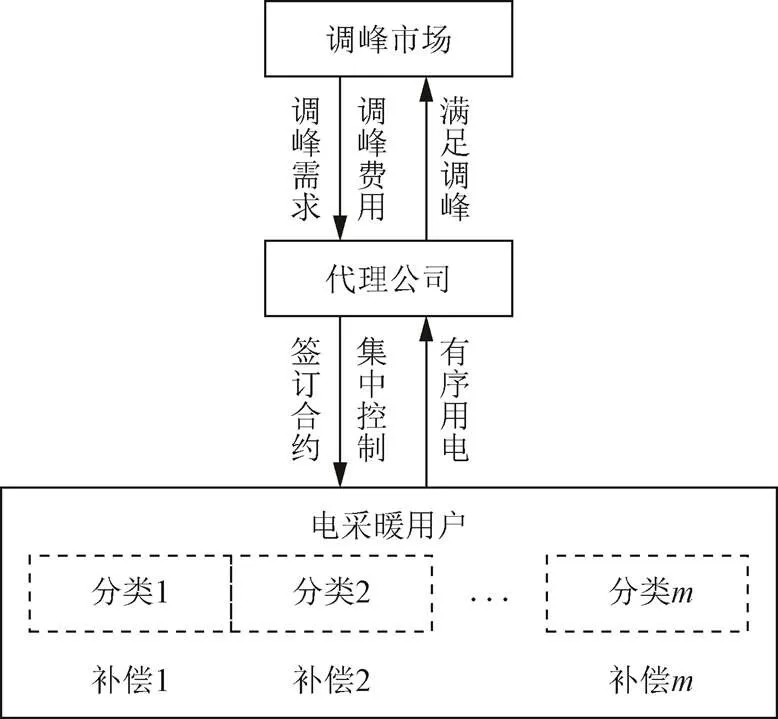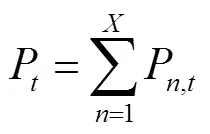基于需求侧调峰的农村电采暖设备负荷优化控制策略
2020-06-20陆斯悦及洪泉唐皓淞董彦君于海波杜松怀
陆斯悦,及洪泉,徐 蕙,唐皓淞,张 禄,苏 娟,董彦君,于海波,杜松怀
基于需求侧调峰的农村电采暖设备负荷优化控制策略
陆斯悦1,及洪泉1,徐 蕙1,唐皓淞3,张 禄1,苏 娟2※,董彦君2,于海波2,杜松怀2
(1. 国网北京市电力公司电力科学研究院,北京 100075;2. 中国农业大学信息与电气工程学院,北京 100083;3.国网北京市电力公司海淀供电公司,北京,100031)
随着中国北方地区农村清洁能源供暖项目的大力推广,冬季燃煤取暖污染问题得到了极大的改善。但是大规模煤改电设备的使用,对低压配电网供电可靠性提出了新的挑战。挖掘电采暖负荷的需求响应潜力,激励用户主动参与电网调峰,是实现资源优化配置和提高配电网供电质量的有效措施之一。该文为了激励用户主动参与调峰,实现负荷削峰填谷,提出了基于需求侧调峰的农村电采暖设备负荷优化控制策略,设计了第三方公司代理“煤改电”用户参与调峰市场的市场交易模式,在此交易模式下建立了考虑调峰需求和用户舒适度的负荷优化控制模型,并在模型中引入用户分类补偿机制,提高用户参与调峰的主动性。以北京平谷区电采暖用户负荷数据为例进行仿真分析,结果表明,该文所提方法可以在满足用户室温需求的情况下,实现负荷削峰填谷的作用,分类补偿机制对用户主动参与调峰起到了激励作用,使用户和代理公司均获得收益。
空气源热泵;电;采暖;需求响应;削峰填谷;优化控制策略
0 引 言
为了治理环境污染,中国北方地区大力推广清洁能源供暖工程。2018年7月底,清洁取暖试点城市申报范围扩展至京津冀及周边地区大气污染防治传输通道的“2+26”城市[1-2]。2018年底,北京城郊农村地区的电采暖设备安装已经基本完成[3]。随着煤改电用户的快速增长,农村低压配电网基础设施改造需求以及电力供需压力急剧上升。为了缓解电力供需矛盾,鼓励煤改电用户积极参与需求响应,实现负荷削峰填谷,提高电网负荷率和运行效率。单个电采暖用户需求响应容量较小,调峰效果较差,将区域电采暖用户的需求响应容量聚集起来参与调峰是一种有效解决方案。因此,可对区域电采暖设备进行集中负荷控制,研究其参与电网调峰的需求响应策略。
目前,需求侧能量管理的相关研究中,直接负荷控制(Direct Load Control,DLC)方案[4]是研究的热点。DLC是指在用户允许的情况下,调度机构依据电网需求,全权控制用户的设备运行,兼顾用户的供电质量和生活舒适度,并在实施后由代理公司对参与用户提供经济补偿[5-6]。
DLC控制策略以系统运行成本最小化或代理公司利润最大化为目标[7-10],并兼顾系统运行成本、公司利润和用户满意程度[11-16],其求解方法从传统优化算法(例如线性规划、多目标线性规划、动态规划[17-18]、模糊线性规划[19-23]和模糊动态规划法等)发展到智能优化算法(例如遗传算法、多目标进化算法和蚁群算法等)。但是,已有温控负荷的DLC研究大多针对制冷空调,对于电采暖设备的研究较少。电采暖用户参与调峰的优化控制策略也鲜有报道。
为了缓解电采暖设备的大规模投入或改造给农村电网带来的供电能供给的压力,本文基于考虑农村地区的调峰需求,挖掘需求侧可控负荷资源的响应潜力,提出代理公司控制区域电采暖设备参与区域调峰的市场模式,建立代理公司对电采暖负荷的最优控制模型,以最大程度满足调峰需求和代理公司收益最大化为目标,并考虑电采暖用户的温度舒适度需求和用户可控度差异化补偿机制,并以北京平谷区电采暖用户为例进行仿真分析,验证所提方法的有效性。
1 区域电采暖设备参与调峰市场模式
电采暖负荷具有快速响应能力,单个用户的可控容量虽然有限,但随着电采暖用户的增加,区域电采暖将形成庞大的可控容量,可以对电采暖用户进行集中控制,参与调峰市场。
本文调峰市场模式为代理公司集中控制电采暖用户设备,根据调峰市场投标获得的调峰量与相应的价格,对合约用户进行设备集中控制,以满足调峰需求和公司的收益,并通过经济补偿激励用户参与调峰。其中代理公司可以是售电公司、负荷聚合商等第三方机构。由于用户数量较多,用电需求、舒适度需求、可控时段等均有差异,代理公司可对用户进行分类管理。为了激励用户主动接受代理公司的优化控制策略,参与调峰市场,可采用考虑用户可控度的差异化补偿机制,即根据用户可控的难易程度采用分类定价的方法给予用户补偿,进一步激励用户参与调峰。代理公司控制电采暖设备参与调峰市场的模式如图1所示。

图1 区域电采暖设备参与调峰市场模式
在这种市场模式下,有一部分用户可能不愿意接受调控。因此,为了激励用户主动参与调峰,应当开放控制权。本文提出了一种按照用户可控程度的分类补偿机制。以用户自身用电行为,如室温、允许受控时段和负荷响应能力等指标对用户可控度进行划分。容易控制的用户,优先调度,且给予较高的补偿价格。为了详细阐述本文所提的负荷优化控制策略,假设已根据可控度指标将用户划分为3类,补偿价格已知,忽略调峰市场的交易过程。
目前电采暖设备主要有空气源热泵、地源热泵和蓄热式采暖等[21-22]。北京郊区农村的煤改电项目主要采用空气源热泵,因此本文针对空气源热泵提出直接负荷控制方法。
2 区域电采暖设备用电负荷优化控制模型
考虑调峰需求和代理公司收益,建立直接负荷控制的多目标优化模型。目标函数包括峰时段电采暖负荷最小,即最大程度满足调峰需求,根据目前实际运行情况,可集中控制的用户容量较小,可以满足部分调峰需求,且忽略了调峰总量约束;代理公司效益最大,即支付的补偿费用最小。约束条件包括用户峰时段功率约束;用户室温舒适度约束;用户可控时段约束。
2.1 目标函数
2.1.1 峰时段用电负荷最小




2.1.2代理公司效益最大




2.2 约束条件
2.2.1 用户峰时段功率约束
由于模型的设备初始运行负荷是以设备额定功率为限,所以可能比实际运行的负荷峰值还要大,为了避免这一异常现象,满足电采暖设备实际运行要求,需要考虑用户设备的运行约束,即电采暖设备在任意时刻的运行负荷不超过历史负荷峰值:

2.2.2 温度约束

空气源热泵的温控模型表征空气源热泵的运行状态,如式(9)所示,需要考虑热泵自身功率、环境温度、房屋热力学参数等[25]。



式中CR为房屋系数(与隔热等级,体积,墙壁表面积等相关)。
2.2.3 用户可控时段约束
用户在与代理公司签订合同时提交可控时段条件。代理公司对每个用户的优化控制时段必须与该用户签订的可控时段一致,即用户实际受控时段在其允许受控时段范围内。可控时段约束如式(11)所示。

3 负荷优化控制策略
在代理公司集中控制电采暖负荷参与调峰市场模式下,代理公司对用户的优化控制主要包括4个步骤:
1)电采暖用户申报控制条件
电采暖用户向代理公司提供电采暖设备型号、容量、可控时段、温度要求、地理位置等信息;
2)签订集中控制协议
根据用户申报的可控条件,对用户进行分类,并制定分类补偿价格;根据各用户的温度需求设定统一的舒适温度。依据分类结果与用户签订集中控制协议;
3)设置集中控制模型初始参数
根据与用户签订的集中控制协议(内容包括室温需求、设备型号、设备允许受控时段等),以及用户实际用电环境,设置用户使用的空气源热泵额定功率、室内舒适温度和用户房屋热时间常数等初始参数。
4)生成最优控制方案
本文采用遗传算法[27-28]对集中控制模型求解,得到最优负荷控制方案,对用户实施相应的控制手段,并根据最终结果给予用户补偿。
4 算例分析
选取北京平谷区山东庄村20户电采暖用户进行仿真分析。根据2019年2月18日的实际负荷及天气等数据,采用本文提出的区域电采暖设备负荷优化控制策略对空气源热泵运行时间进行优化控制仿真分析,并与用户当天实际运行数据进行对比,对优化控制方案、用户温度和代理公司收益进行分析,以验证本文方法的有效性。
将用户按照用户可控度不同分为3组,可控度依次降低,其对应的负荷削减补偿价格分别为0.15、0.13和0.10元/kWh。设置初始温度18 ℃,温升系数20 ℃,状态改变阈值2 ℃,热时间常数120 min,空气源热泵额定功率10 kW。将最小负荷控制间隔设定为15 min,一天24 h内共有96个控制时段,设定用户的舒适温度为18 ℃。
4.1 最优控制方案


表1 最优控制方案下调控调控时段统计
注:每15 min为1个时段.
Note: Every 15 minutes is a period.
图2为3组20个用户在峰时段(10:00-21:00)采用本文控制策略集中控制的负荷仿真结果相对于当日实际负荷的削减量。由图2可知,各组用户的负荷平均削减量分别为9.128、7.654和7.347 kWh,依次递减。峰时段所有电采暖设备的总负荷削减量为159.773 kWh,且每户的负荷削减量在平均削减量7.989 kWh附近波动,说明模型对于各用户的控制比较均衡,没有出现过度控制某个用户的情况,保证了用户的正常取暖,同时能很好地实现用户电采暖设备的有序错峰用电。
图3为3组20个用户执行DLC后的总负荷仿真结果与实际未经过DLC控制的总负荷结果曲线。可以看出,控制前后负荷曲线的峰谷时段发生了交换,这表明本文所提出的集中控制模型可以很好地实现电采暖设备的错峰用电,起到对电网削峰填谷的作用。

图2 峰时段各组用户的负荷削减量

图3 集中控制前后的用电负荷曲线
4.2 室内温度分析
根据最优控制方案计算结果得到最优调度时20个用户的平均室温变化曲线,如图4所示。根据《北京市居民供热采暖合同(按面积计费版)》,当室外日平均气温在-7 ℃以上时,卧室、起居室温度应不低于18 ℃,故设置用户舒适温度为18 ℃,即图4中虚线区域。


图4 受控用户的平均室内温度变化曲线
Fig4 Average indoor temperature change curve of controlled users
4.3 代理公司收益分析
本文以代理公司收益最大化和调峰需求作为目标函数进行电采暖用户的集中优化控制。将本文方法与仅考虑调峰需求作为目标函数的集中优化控制模型进行对比,得出代理公司在2种控制策略下应支付的补偿费用,结果如表2所示。
由表2可知,不考虑效益目标时,代理公司每日支付的补偿费用均高于考虑经济效益的补偿费用。实施DLC控制后,代理公司应支付给20个用户的总补偿费用为63.514元,若不考虑代理公司经济效益目标并进行DLC模型控制,代理公司的补偿支出应为93.241元,考虑经济效益目标后单日补偿费用可节省31.9%。因此,在实施DLC计划前,考虑代理公司的效益因素对减少补偿费用支出是十分必要的。


表2 2种控制策略下的代理公司补偿费用对比
5 结 论
本文针对空气源热泵采暖设备,提出了区域电采暖设备参与调峰的用电负荷优化控制策略,提出了代理公司集中控制电采暖用户参与调峰市场模式以及在该模式下代理公司根据用户可控度的分类补偿机制。在此模式下,建立了考虑用户舒适度的负荷集中优化控制模型。
1)城乡居民采暖设备进行电代煤改造是京津冀地区蓝天保卫战的措施之一。为了缓解大量电采暖负荷的增加带来的电力供需压力,可发挥电采暖负荷的快速响应能力,引导区域电采暖负荷主动调峰需求响应。
2)以北京平谷区电采暖用户负荷数据为例,进行仿真分析。结果表明,用户用电曲线的峰谷发生了变化,起到了削峰填谷的作用,可以缓解上级电网的峰荷时段压力;用户室内温度在(18±1)℃范围波动,满足冬季取暖的舒适温度需求;考虑代理公司收益最大化,对20个用户的单日补偿费用可节省31.9%;考虑用户可控度的分类补偿机制,使可控度最高的用户获得收益补偿最多,可以起到激励用户主动参与调峰需求响应的作用。
[1] 蒋建云,章永洁,叶建东,等. 北京农村地区燃煤供暖替代技术方案实效对比[J]. 暖通空调,2016,46(9):51-55. Jiang Jianyun, Zhang Yongjie, Ye Jiandong, et al. Effectiveness comparision and analysis of alternative solutions to coal-fired heating in rural Beijing[J]. Heating Ventilating & Air Conditioning, 2016, 46(9): 51-55. (in Chinese with English abstract)
[2] 王红霞. 燃煤锅炉房清洁能源改造工程的技术探讨[J]. 区域供热,2013(1):43-47. Wang Hongxia. Technical discussion on clean energy reconstruction project of coal-fired boiler house[J]. District Heating, 2013(1): 43-47. (in Chinese with English abstract)
[3] 王青平. 农村住宅空气源热泵供暖系统应用与探讨[J]. 制冷与空调,2017(3):77-80. Wang Qingping. Application and discussion of air source heat pump heating system in rural residential buildings[J], Refrigeration and Air-Conditioning, 2017(3): 77-80. (in Chinese with English abstract)
[4] Strbac G, Kirschen D. Assessing the competitiveness of semand-side bidding[J]. IEEE Transactions on Power Systems, 1999, 14(1): 120-125.
[5] Le K D, Boyle R F, Hunter M D, et al. A procedure for coordinating direct-load-control strategies to minimize system production costs[J]. Power Apparatus & Systems IEEE Transactions on, 1983, 102(6): 1843-1849.
[6] Bhatnagar R, Rahman S. Dispatch of direct load control for fuel cost minimization[J]. IEEE Transactions on Power Systems, 1986, 1(4): 96-102.
[7] Yu Zuwei, Breipohl A M, Lee F N, et al. An analytical method for comparing natural diversity to DSM controlled diversity[J]. IEEE Transactions on Power Systems, 1996, 11(3): 1201-1208.
[8] 曹世光,李卫东,柳焯,等. 计及直接负荷控制的动态优化调度模型[J].中国电机工程学报,1998(3):160-162. Cao Shiguang, Li Weidong, Liu Zhuo, et al. Model of dynamic optimal dispatch considering direct load control[J], Proceedings of the CSEE, 1998(3):160-162. (in Chinese with English abstract)
[9] Kah Hoe Ng, Sheble G B. A profit-based load management using linear programming[J]. IEEE Transactions on Power Systems, 1998, 13(2): 688-694.
[10] Yang H T, Huang K Y. Direct load control using fuzzy dynamic programming[J]. IEEE Proceedings-Generation, Transmission and Distribution, 1999, 146(3): 294-300.
[11] Jorge H, Antunes C H, Martins A G. A multiple objective decision support model for the selection of remote load control strategies[J]. IEEE Transactions on Power Systems, 2002, 15(2): 865-872.
[12] Leehter Yao, Chang Wenchi, Yen Rongliang. An iterative deepening genetic algorithm for scheduling of direct load control[J]. IEEE Transactions on Power Systems, 2005, 20(3): 1414-1421.
[13] Karthik Sindhya, Ana Belen Ruiz, Kaisa Miettinen. A preference based interactive evolutionary algorithm for multi-objective optimization: PIE[J]. Springer Berlin Heidelberg, 2011, 6579: 212-225.
[14] Andreea Vescan, Crina Grosan. A hybrid evolutionary multiobjective approach for the component selection problem[J]. Springer Berlin Heidelberg, 2008, 5271: 164-171.
[15] 赵庆杞,黎明,张化光. 基于蚁群算法的灵敏负荷调度[J],中国电机工程学报,2006,26(Z1):15-21. Zhao Qingqi, Li Ming, Zhang Huaguang. Dispatching strategy of responsive load using ant colony algotithm[J], Proceedings of the CSEE, 2006, 26(Z1): 15-21. (in Chinese with English abstract)
[16] Molina, Gabaldon A, Fuentes J A, et al. Implementation and assessment of physically based electrical load models: Application to direct load control residential programmes[J]. IEEE Proceedings-Generation, Transmission and Distribution, 2003, 150(1): 61-66.
[17] Leehter Yao, Hau Ren Lu. Optimization of two-way direct load control based on fuzzy linear programming[C]. Hongkong: IEEE International Conference on Fuzzy Systems, 2008: 1894-1901.
[18] Leehter Yao and Hau Ren Lu.A two-way direct control of central air-conditioning load via the internet[J]. IEEE Transactions on Power Delivery, 2009, 24(1): 240-248.
[19] 许道林,谢松. 基于模糊线性规划的居民直接负荷控制[J],电力需求侧管理,2007,9(1):15-18. Xu Daolin, Xie Song. Direct residential load control based on fuzzy linear programming[J]. Power Demand Side Management 2007, 9(1):15-18. (in Chinese with English abstract)
[20] 唐为民,王蓓蓓,施伟. 基于模糊动态规划的直接负荷控制策略研究[J].中国电力,2003,36(8):24-28. Tang Weimin,Wang Beibei,Shi Wei. The strategy researeh of direct load control based on fuzzy dynamic program[J], Electric Power, 2003,36(8):24-28. (in Chinese with English abstract)
[21] 王美芝,薛晓柳,刘继军等. 不同节能改造方式猪舍的供暖能耗和经济性比较[J]. 农业工程学报,2018,34(13):218-224. Wang Meizhi, Xue Xiaoliu, Liu Jijun, et al. Comparison of heating energy consumption and economy of pig house with different energy saving renovation measures[J]. Transactions of the Chinese Society of Agricultural Engineering (Transactions of the CSAE), 2018, 34(13): 218- 224. (in Chinese with English abstract)
[22] 王美芝,刘继军,吴中红,等. 地源热泵技术对规模化猪场节能减排的影响[J]. 农业工程学报,2011,27(4):251-254. Wang Meizhi, Liu Jijun, Wu Zhonghong, et al. Effect of ground-source heat pump applied to piggery on energy saving and emission reduction[J]. Transactions of the CSAE, 2011, 27(4): 251-254. (in Chinese with English abstract)
[23] 丛宏斌,赵立欣,王久臣,姚宗路. 中国农村能源生产消费现状与发展需求分析[J]. 农业工程学报,2017,33(17):224-231. Cong Hongbin, Zhao Lixin, Wang Jiuchen, et al. Current situation and development demand analysis of rural energy in China[J]. Transactions of the Chinese Society of Agricultural Engineering (Transactions of the CSAE), 2017, 33(17): 224-231. (in Chinese with English abstract)
[24] 邓可蕴,王革华,贺亮. 农村能源发展战略重点与技术的选择评价[J]. 农业工程学报,1997(3):185-188. Deng Keyun, Wang Gehua, He Liang. Selection and evaluation of focal points and technologies on rural energy development strategy[J]. Transactions of the Chinese Society of Agricultural Engineering (Transactions of the CSAE), 1997(3):185-188. (in Chinese with English abstract)
[25] 丛宏斌,赵立欣,孟海波,等. 生物质热解多联产在北方农村清洁供暖中的适用性评价[J]. 农业工程学报,2018,34(1):8-14. Cong Hongbin, Zhao Lixin, Meng Haibo, et al. Applicability evaluation of biomass pyrolytic poly-generation technology on clean heating in northern rural of China[J]. Transactions of the Chinese Society of Agricultural Engineering (Transactions of the CSAE), 2018, 34(1): 8-14. (in Chinese with English abstract)
[26] Ucak C, Caglar R. The effects of load parameter dispersion and direct load control actions on aggregated load[J]. International Conference on Power System Technology Proceedings, 1998, 280-284
[27] 林龙成. 基于遗传算法的改进K-means算法[J/OL]. 电子技术与软件工程,2020(1):111-112. Lin Longcheng. Improved K-means algorithm based on genetic algorithm[J/OL]. Electronic Technology & Software Engineering, 2020(1):111-112. (in Chinese with English abstract)
[28] 吉根林. 遗传算法研究综述[J]. 计算机应用与软件,2004,21(2). Ji Genlin. A review of research on genetic algorithms[J], Computer Applications anSoftware, 2004, 21(2). (in Chinese with English abstract)
Optimal load control strategy of rural electric heating equipments based on demand side peak load regulation
Lu Siyue1, Ji Hongquan1, Xu Hui1,Tang Haosong3, Zhang Lu1, Su Juan2※, Dong Yanjun2, Yu Haibo2, Du Songhuai2
(1.,,100075,; 2.,,100083,3.100031,)
With the implementation of clean energy heating project in rural areas of northern China, the pollution of coal-fired heating in winter has been greatly improved. However, the use of large-scale electric heating equipment put forward new challenges to the power supply reliability of low-voltage distribution network. Especially in rural power grid, the load is heavy in winter and low in other seasons. It is one of the effective measures to achieve optimal resource allocation and improve the power supply quality of the distribution grid to exploit the demand response potentialities of electric heating loads, and motivate electric heating loads to actively respond to demand response programs (DRP) for peak-load shifting. Therefore, a load optimal control strategy for rural electric heating equipments based on demand side peak load regulation was proposed in this paper. A market transaction model was designed for third-party agency companies to represent coal-to-electricity users in the peak shaving market. The agency company made the centrally control strategies of electric heating users’ equipment according to the peak shaving volume and corresponding price obtained from the peak shaving market bidding. The electric heating users were classified based on the controllability of each user by the agency company. Each kinds of users could get different compensation price to encourage them to participate in the demand response programs for peak-load shifting. In this market model, a multi-objective optimization model was established to control the users’ air source heat pump. The goals of the optimization model were to meet the user's temperature demands to the maximum extent and to maximize the benefit of the agent company. Meanwhile, user's comfort requirements for indoor temperature were considered in this model, and the user classification compensation mechanism was introduced to improve the user's initiative to participate in peak load regulation. Taking the load data of electric heating users in Pinggu District of Beijing as an example, the simulation analysis was carried out. The results show that the total load reduction of all electric heating equipment was 159.773 kWh, there was no over-control for anyone user, the load reduction of each user fluctuated around average reduction of 7.989 kWh, the peak valley of the user's power consumption curve was changed, the optimal control strategy proposed in this paper played the role of peak load reduction and valley filling, which can relieve the pressure of the upper power grid during peak load period. The indoor temperature of the users was (18±1) ℃, which meet the demand of comfortable temperature for heating in winter. Compared with the target of not considering the benefit, the one-day compensation cost of the agency company was saved 31.9%, and the users with the highest degree of control got the most compensation income, the peak load regulation strategy could encourage the users to participate in the peak load regulation actively.
air source heat pump; electricity; heating; demand response; peak-load shifting; optimal control strategy
陆斯悦,及洪泉,徐蕙,等. 基于需求侧调峰的农村电采暖设备负荷优化控制策略[J]. 农业工程学报,2020,36(7):229-234. doi:10.11975/j.issn.1002-6819.2020.07.026 http://www.tcsae.org
Lu Siyue, Ji Hongquan, Xu Hui, et al. Optimal load control strategy of rural electric heating equipments based on demand side peak load regulation[J]. Transactions of the Chinese Society of Agricultural Engineering (Transactions of the CSAE), 2020, 36(7): 229-234. (in Chinese with English abstract) doi:10.11975/j.issn.1002-6819.2020.07.026 http://www.tcsae.org
2019-11-04
2020-03-06
国家自然科学基金青年科学基金项目课题(51707197);“十三五”国家重点研发计划项目(2016YFB0900101)
陆斯悦,工程师,研究方向为电力大数据分析。Email:lusiyue2006@126.com
苏娟,博士,副教授,主要研究方向电力市场、电力需求侧管理等。Email:sujuan@cau.edu.cn
10.11975/j.issn.1002-6819.2020.07.026
S147.2
A
1002-6819(2020)-07-0229-06
